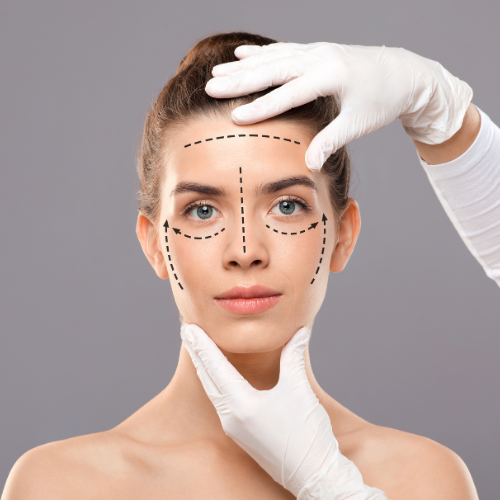Rhinoplasty

Rhinoplasty: Reshaping Your Nose for Aesthetic and Functional Enhancement
Clinically referred to as rhinoplasty but commonly known as “nose job,” this surgical procedure is designed to reshape and enhance the appearance of the nose or improve its functionality. It can be performed for various reasons, such as addressing aesthetic concerns, correcting birth defects, improving breathing, or repairing damage caused by trauma. During rhinoplasty, the nasal bone and cartilage are modified to achieve the desired shape, size, or proportion. This procedure is highly customizable and can be tailored to the unique goals of each patient. Rhinoplasty can have a significant impact on a person’s self-esteem and overall facial harmony, making it a popular choice for those seeking nasal enhancement.
Types of Rhinoplasty
Rhinoplasty comes in several forms, each designed to meet specific needs:
This is the initial surgical procedure to enhance the appearance or function of the nose, often addressing aesthetic concerns, correcting birth defects, improving breathing, or resolving trauma-related issues, and it is typically chosen by individuals without prior nasal surgeries.
This is a cosmetic nose surgery procedure that specifically targets the nasal tip. It involves reshaping and refining the tip of the nose to improve its appearance. Tipplasty is chosen by individuals looking to enhance nasal tip symmetry, projection, or definition, resulting in a more balanced and aesthetically pleasing nose.
This is a surgical procedure performed to correct or enhance the results of a previous rhinoplasty (nose job). It addresses any remaining aesthetic or functional issues, including asymmetry, breathing problems, or dissatisfaction with the initial surgery’s outcome. Revision rhinoplasty is tailored to each patient’s specific needs and is often more complex than primary rhinoplasty due to alterations made during previous surgeries.
Functional Septorhinoplasty is a surgical procedure that combines both aesthetic and functional aspects of rhinoplasty. It aims to improve both the appearance and functionality of the nose. This surgery is commonly performed to correct structural issues like a deviated septum or turbinate hypertrophy that can cause breathing difficulties. It results in a nose that not only looks better but also functions more effectively for improved airflow and breathing.
Rhinoplasty Techniques
Various techniques can be employed in rhinoplasty, depending on the patient’s goals and specific issues to be addressed. Common techniques include:
Closed Rhinoplasty is a surgical approach where incisions are made inside the nose, avoiding external scars. This technique is suitable for less complex nose surgeries, allowing for alterations to the nasal structure without visible external marks, resulting in a more discreet and concealed healing process.
Open Rhinoplasty is a surgical method involving a small incision made across the columella, the tissue between the nostrils. This technique provides better visibility and access to the nasal structures, making it ideal for complex or extensive nose surgeries. It allows surgeons to address intricate issues and achieve precise results, although it may leave a small external scar on the columella.
Pre-Rhinoplasty Preparation
Preparation for rhinoplasty includes necessary steps for both the patient and the surgeon to ensure a successful procedure:
Consultation: It begins with the initial consultation to discuss goals, evaluate nasal structure, and establish realistic expectations.
Medical Assessment: Detailed medical history, nasal examinations, and photographic documentation assist in identifying specific issues.
Personalized Plan: A tailored surgical plan is created based on the patient’s goals and the surgeon’s assessment.
Preoperative Instructions: Instructions are received regarding medication, alcohol, smoking, and dietary restrictions leading up to the surgery.
Medical Clearance: If necessary, medical evaluations are undergone to prepare for surgery.
Informed Consent: Consent forms detailing risks and benefits, with thorough explanations, are reviewed and signed.
Post-Rhinoplasty Recovery Process
Immediate Post-Op: After rhinoplasty, patients spend some time in a recovery area for monitoring. Any discomfort is managed with pain medication.
Swelling and Bruising: Swelling and bruising around the nose and eyes are common and peak within 48 hours. Cold compresses and elevation of the head help alleviate these symptoms.
Nasal Packing and Splints: Nasal packing and splints are often placed to support the healing nasal structure. They are usually removed within a week.
Rest and Activity: Rest is crucial during the initial days. Strenuous activities should be avoided for several weeks.
Follow-Up Appointments: Patients have several follow-up appointments with their surgeon to monitor progress and address any concerns.
Diet and Medication: A soft diet is recommended initially. Medications, including antibiotics and pain relievers, are prescribed.
Recovery Timeline: Swelling gradually decreases over weeks and months, with final results becoming apparent after a year.
Sun Protection: Protecting the nose from sun exposure is essential during the healing process.
Resuming Normal Activities: Gradually, patients can resume their normal activities as advised by the surgeon.
Patience: Patience is key, as complete recovery and final results may take time, and each patient’s experience varies.





